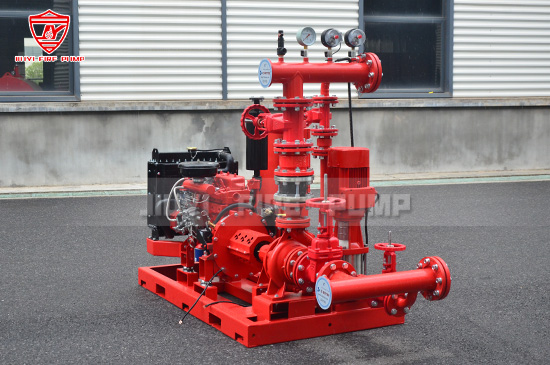Correctly identifying fire pump rotation is crucial before installation. Improper rotation can lead to severe pump damage, reduced efficiency, and even total system failure. For fire protection systems, where reliability is non-negotiable, ensuring correct rotation direction is essential.
In this guide, we will walk you through everything you need to know about fire pump rotation—what it means, how to identify it, and the correct procedures to verify it for electric motors and diesel engines. Whether you're a fire pump installer, maintenance engineer, or system designer, this article will help you avoid costly errors and ensure your pump operates correctly.

Fire pump rotation refers to the direction in which the pump shaft turns during operation. It is typically described from the perspective of looking at the pump from the drive end, which is usually the motor or diesel engine side.
There are two types of rotation:
Clockwise (CW): Also known as right-hand rotation.
Counter-Clockwise (CCW): Also known as left-hand rotation.
Different pump models and installations require different rotation directions. Therefore, confirming the required and actual rotation before coupling the pump to its driver is critical.
Incorrect pump rotation can lead to:
Severe damage to internal components such as impellers and wear rings
Reduced flow and head performance
System inefficiency or failure during fire emergencies
Voiding of manufacturer warranty
Costly downtime and repair
Since fire pumps are installed as part of life safety systems, every detail—including shaft rotation—must be verified.
The required direction of rotation for a fire pump is usually:
Stamped on the Pump Casing: Look for an arrow embossed or engraved on the pump housing.
Specified in the Manufacturer’s Manual: The installation and operation manual will clearly state the rotation requirement.
Marked on the Coupling Guard or Nameplate: Some pumps include labels or directional arrows directly on the coupling guard or nameplate.
Always confirm the direction before installing the driver or coupling the pump.
Here’s a structured method for checking fire pump rotation, depending on the type of driver: electric motor or diesel engine.
If the pump and motor/engine are not yet coupled:
Use a strap wrench or turn the bare shaft gently by hand.
Watch the impeller through the suction or discharge opening.
Observe which direction the shaft spins.
Compare this to the rotation arrow marked on the pump casing or manual.
Most fire pump motors are three-phase. Their rotation direction can be reversed simply by swapping any two of the three power supply lines (phases).
Steps:
Ensure the Motor Is Uncoupled from the pump.
Jog the Motor Briefly (bump start) using the local control panel.
Observe the shaft or coupling direction.
Compare to the Required Pump Rotation.
If the direction is wrong:
Turn off the power.
Swap any two of the three power supply wires (L1, L2, L3).
Jog the motor again to verify the new direction.
Note: Never run the motor for more than 1–2 seconds during jogging. Always follow electrical safety protocols.
For diesel engine-driven fire pumps, rotation is not reversible like with electric motors.
Steps:
Refer to the engine nameplate or technical manual. It will specify the rotation direction—usually “clockwise” or “counter-clockwise” as viewed from the flywheel end.
Verify the rotation matches the pump’s required direction.
If the diesel engine's rotation does not match the pump:
The pump model must be changed to match the engine, or
Use a right-angle gearbox if permitted, or
Consult the manufacturer for a solution.
Always align the pump rotation with the engine’s fixed rotation during procurement.
Once you have confirmed both the pump’s required direction and the motor/engine’s actual rotation:
Visually check the alignment between driver and pump.
Manually rotate the coupling and verify shaft movement.
Reconfirm markings on casing and nameplate.
Proceed with coupling only if the directions match.
Coupling Before Checking Rotation
This can lead to startup with reverse rotation, damaging the pump instantly.
Ignoring the Directional Arrow
Always double-check the pump casing for the required rotation direction.
Assuming Motor Rotation is Always Correct
Jogging is necessary—don't rely on assumptions.
Skipping Documentation
Record the checked direction and method used for compliance and warranty tracking.
If you discover that the driver’s rotation does not match the pump:
For Electric Motors: Swap two phase wires to reverse direction.
For Diesel Engines: You cannot reverse the rotation; consult your supplier for a compatible pump or gearbox.
Still Unsure? Contact your pump manufacturer with the pump model and driver details. They can assist with compatibility verification.
Use a rotation meter on electric motors for quick and safe verification.
In system commissioning, include rotation verification as a mandatory checklist item.
Educate your team or client about the importance of rotation checks to prevent liability.
Attach permanent labels indicating correct rotation near the pump for future maintenance teams.

Correctly determining the rotation of a fire pump is a critical yet often overlooked step in the installation and commissioning process. Verifying rotation protects the equipment, ensures proper system operation, and upholds the integrity of life safety systems.
Whether you are installing an electric motor-driven or diesel engine-driven fire pump, always follow the correct procedures to confirm rotation direction before coupling. When in doubt, consult your fire pump manufacturer for assistance.